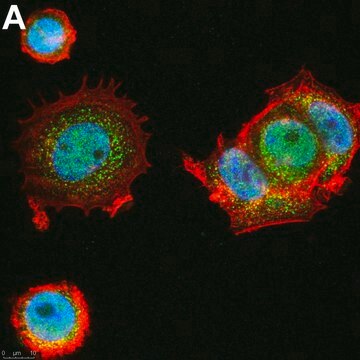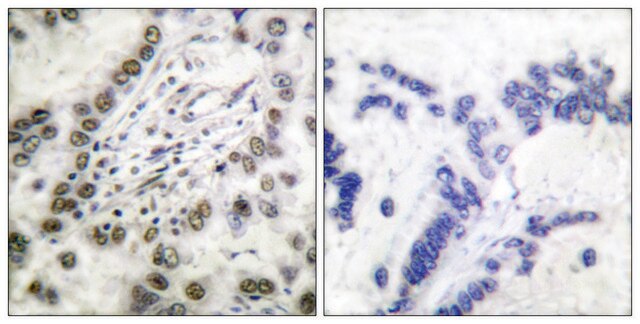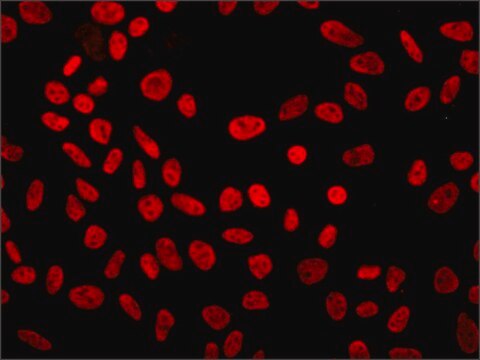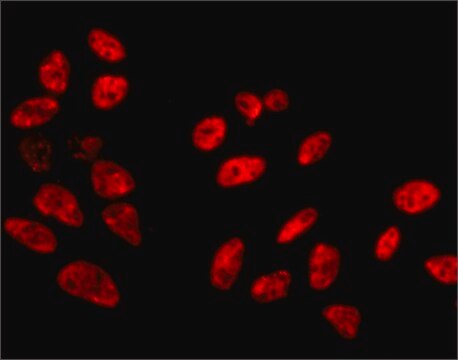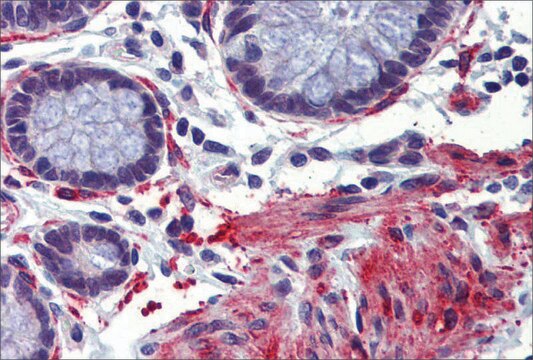General description
ZooMAb® antibodies represent an entirely new generation of recombinant monoclonal antibodies.Each ZooMAb® antibody is manufactured using our proprietary recombinant expression system, purified to homogeneity, and precisely dispensed to produce robust and highly reproducible lot-to-lot consistency. Only top-performing clones are released for use by researchers. Each antibody is validated for high specificity and affinity across multiple applications, including its most commonly used application. ZooMAb® antibodies are reliably available and ready to ship when you need them.
Specificity
Clone 3N20 is a ZooMAb® Rabbit recombinant monoclonal antibody that specifically detects CREB-binding protein (CBP). It targets an epitope within 25 amino acids from the N-terminal region.
Immunogen
KLH-conjugated linear peptide corresponding to 25 amino acids from the N-terminal region of human CREB-binding protein (CBP).
Application
Quality Control Testing
Evaluated by Immunocytochemistry in MCF-7 cells.
Immunocytochemistry Analysis: A 1:100 dilution of this antibody detected CREB-binding protein (CBP) in MCF-7 cells.
Tested Applications
Affinity Binding Assay: A representative lot of this antibody bound CREB-binding protein (CBP) peptide with a KD of 1.3 x 10-7 in an affinity binding assay.
Immunohistochemistry (Paraffin) Analysis: A 1:100 dilution from a representative lot detected CREB-binding protein (CBP) in human testis tissue sections.
Note: Actual optimal working dilutions must be determined by end user as specimens, and experimental conditions may vary with the end user.
Target description
CREB-binding protein (UniProt: Q92793; also known as EC: 2.3.1.48, Histone lysine acetyltransferase CREBBP, Protein-lysine acetyltransferase CREBBP) is encoded by the CREBBP (also known as CBP) gene (Gene ID: 1387) in human. CBP, a homolog of p300, serves as a transcriptional co-activator of various sequence-specific transcription factors that are involved in a wide array of cellular activities, such as DNA repair, cell growth, differentiation, and apoptosis. It possesses intrinsic acetyltransferase activity by which it acetylates histones, giving specific tag for transcription activation. It can also acetylate non-histone proteins, such as DExD-box helicase 21, interferon regulatory factor 2, and nuclear receptor coactivator 3. CBP facilitates the transcription of active genes by acting as adapter protein bridging DNA binding transcription factors to the basal transcription machinery and by loosening chromatin through histone tail acetylation. It binds specifically to phosphorylated CREB and enhances its transcriptional activity toward cAMP-responsive genes. CBP and p300 share overall 63% amino acid sequence identity and about 90% homology in their histone acetyltransferase domain (aa 1323-1700). Structurally, CBP contains several domains: a receptor-interacting domain (RID); KIX binding site of CREB; a bromo domain (aa 1103-1175); three cysteine and histidine-rich domains, a glutamine-and proline-rich domain (QP), and a steroid receptor co-activator-1 interaction domain (SID). Methylation of the KIX domain by coactivator associated arginine methyltransferase 1 (CARM1) blocks its association with CREB that results in the blockage of CREB signaling. Phosphorylation of CBP by IKK- at serine 1382 and 1386 promotes cell growth by switching the binding preference of CBP from TP53 to NF-kB. This ZooMAb® recombinant monoclonal antibody, generated by our propriety technology, offers significantly enhanced specificity, affinity, reproducibility, and stability over conventional monoclonals. (Ref.: Das, C., et al. (2014). Proc. Natl. Acad. Sci. USA. 111(12); E1072-E1081; Song, C., et al. (2017). Genes Dev. 31(13); 1370-1381; Karamouzis, MV., et al. (2007). Cell Res. 17(4); 324-332).
Physical form
Purified recombinant rabbit monoclonal antibody IgG, lyophilized in PBS with 5% Trehalose, normal appearance a coarse or translucent resin. The PBS/trehalose components in the ZooMAb formulation can have the appearance of a semi-solid (bead like gel) after lyophilization. This is a normal phenomenon. Please follow the recommended reconstitution procedure in the data sheet to dissolve the semi-solid, bead-like, gel-appearing material. The resulting antibody solution is completely stable and functional as proven by full functional testing. Contains no biocide or preservatives, such as azide, or any animal by-products. Larger pack sizes provided as multiples of 25 µL.
Reconstitution
0.3 mg/mL after reconstitution at 25 µL per vial. Please refer to guidance on suggested starting dilutions and/or titers per application and sample type.
Storage and Stability
Recommend storage of lyophilized product at 2-8°C; Before reconstitution, micro-centrifuge vials briefly to spin down material to bottom of the vial; Reconstitute each vial by adding 25 µL of filtered lab grade water or PBS; Reconstituted antibodies can be stored at 2-8°C, or -20°C for long term storage. Avoid repeated freeze-thaws.
Legal Information
ZooMAb is a registered trademark of Merck KGaA, Darmstadt, Germany
Disclaimer
Unless otherwise stated in our catalog or other company documentation accompanying the product(s), our products are intended for research use only and are not to be used for any other purpose, which includes but is not limited to, unauthorized commercial uses, in vitro diagnostic uses, ex vivo or in vivo therapeutic uses or any type of consumption or application to humans or animals.

